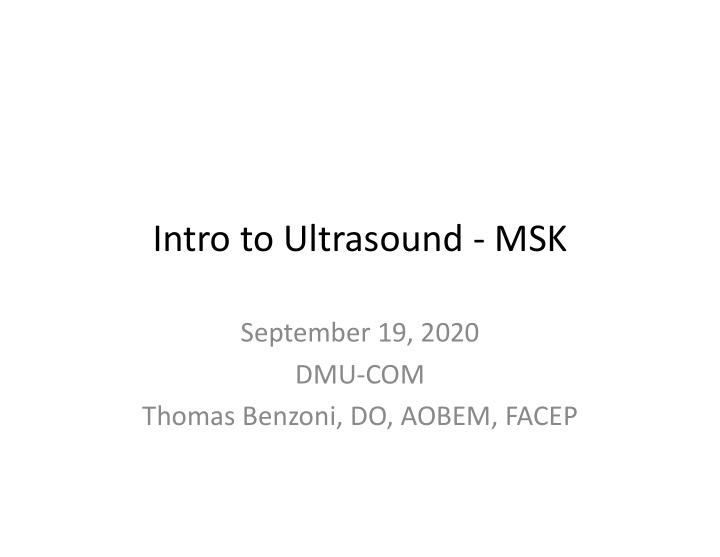



Intro to Ultrasound ‐ MSK September 19, 2020 DMU‐COM Thomas Benzoni, DO, AOBEM, FACEP
Declarations • COI – None • Agency – none • FDA indication deviation – None; these are “radiation emitting devices” • Rules of engagement – Adult conversation
Uses, now and future • “Stethoscope of the future” – Maybe… • Answer a specific question – All good answers start with a good question. • Shock? Which type (tank, pump, pipes)? • Dead? Cardiac motion? • Pregnant? Where/wellbeing? • Access? Seeing is believing…and cannulating. • Fluid? Can I put a needle in there? • Inflated? Better than X‐ray!
Objectives • Basic physics • Machine operation • Probe (transducer) types • Probe manipulation • Obtaining an image • Artifacts • Reporting/exporting/admin (at session end)
Physics • Sound wave sent, received ( trans ducer) – Transducer sends briefly, listens long • Time received ‐ time sent = distance • of incidence = of reflection* – Source of artifact (anisotropy) • Reflection occurs at tissue‐type interfaces • Frequency: α data density, 1/α penetration* – Impacts probe selection
Machine operation • Knobs (“knobology”) – Gain • Does NOT change probe; adds “volume” to signal – Depth • Does NOT change probe – Instructs software to ignore signals after certain time interval – Doppler • Signal approaching = red, receding = blue (convention) – M‐Mode, etc.
Probe types • Curved array – Curved line source, higher frequency; abd. studies • Linear array – Straight line, highest frequency; vascular, MSK • Phased array – Point source, lower frequency, greater penetration – Trauma workhorse, cardio (fast response) • Etc………………………..
Curved Linear Phased Indicator * Source
Beam/inquiry patterns Curved Linear Source Phased
Probe manipulation • Probe marker orientation – Indicates location of specific beam • Probe indicator positioning – Radiology convention: “Right hand generator rule” – Cardiology convention: “Left hand motor rule” • Plane terminology: – Near field, far field – Leading edge, receding edge You must think in 2D/plane terms!!
Probe manipulation • This is important! • Fan = tilt at same contact point • Sweep = move into new plane • Slide = move to extend same plane to side • Rock = tilt to extend plane side to side • Rotate = precise turn about central axis • PRACTICE!
Obtaining an image “Chance favors the prepared mind.” ‐Pasteur • Mental preparation – What’s your question? What is relevant anatomy? • Select most appropriate probe • Apply gel (Benzoni’s rule: more gel) • Manipulate probe • Freeze or cine?
Artifacts • Origins: timing, scatter, energy • Timing creates reverb – Look for frequency/repetition effects • Anisotropy – Beam scatter; look from several angles • Energy absorption – Augmentation – Shadowing
Source
Source
Source
Source
Resources • Ohio State University – everything you need. • U Virginia Medical U/S curriculum • M‐Turbo user manual • Vascular access (Yes, nurses are doing this.) • Dawson/Mallen – Special ACEP offering; superb iBook. • Who can order a test? (CMS) • AFP: POCUS in Family Medicine
Recommend
More recommend